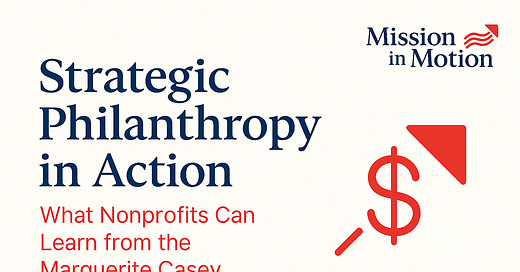Beyond the Check: Strategic Philanthropy in Action
Nonprofit endowments total $1.7 trillion, enough to rival the GDP of a major world economy, such as South Korea. It’s also enough to halve U.S. child poverty for nearly two decades, fund the NIH’s entire research portfolio for over 30 years, or end homelessness for half a century. In a time of compounding crises, we must ask: Are we using this capital to its highest purpose?
Foundations, which comprise 19% of charitable giving, build endowments to stay stable, independent, and impactful over time. The investment income supports steady grantmaking, even in lean years, such as emergencies like COVID-19. Furthermore, endowed foundations are able to increase giving when it matters most and buffer against political and donor volatility. In theory, it lets them stay bold. In practice, it often makes them cautious.
Endowments can also help a foundation look permanent and trustworthy. That credibility attracts partners. But leaders are asking hard questions: Should wealth be preserved while inequality deepens? Should investments align with a mission or just maximize returns?
Ultimately, the question isn’t just “build or spend”, it’s about purpose. Are foundations trying to create impact, or just defer it? In today’s climate, the bigger risk may be staying still. Endowments aren’t trophies. They’re instruments.
One foundation flipped the script. The Marguerite Casey Foundation plans to more than double its annual giving in 2025, jumping to $130 million, up from a typical $23 to $57 million. The number is big. The logic behind it is bigger
According to an APNews article, they’re skipping the usual 5% payout rule and pulling directly from the endowment. The message is clear: urgency matters more than asset preservation. When politics are fragile and communities under-resourced, cash sitting quietly in the market isn’t neutral; it’s a missed opportunity.
Of that $130 million, $40 million is already going to new grantees. Not legacy partners. Not re-ups. These are groups working in journalism, democracy, and power-building. The Foundation isn’t waiting for the perfect proposal. It’s funding in real time.
They’re not alone. MacArthur, Northwest Area Foundation, and others are increasing payouts. MacKenzie Scott’s model of unrestricted giving has made “radical trust” part of the conversation. The old formula of conserve, control, repeat, is giving way to something more urgent, and frankly, more human.
Foundations need to redefine risk. Financial loss isn’t the only danger. Delayed action, shrinking relevance, and mission detachment all carry their own costs. A full endowment means little if democracy hollows out while it sits untouched.
Other foundations are moving away from rigid endowment strategies and blending approaches that balance permanence with urgency. They are turning to mission-aligned investing, which directs their portfolios toward social impact while still generating financial returns. Some, like the Ford Foundation during COVID-19, adopted time-limited spending plans, issuing bonds to quickly scale their response without permanently depleting assets. Increasingly, foundations are using flexible payout models that rise or fall based on context, rather than clinging to the standard 5% rule. It’s a shift from preservation to precision. They are spending when it matters, not just when it’s safe.
We can’t prophesy whether these foundations are an isolated few or the beginning of a larger movement. Only time will tell. However, there are actions nonprofits can take to either meet the shifting trends or at least fortify their strategy and position themselves to take advantage of opportunities without suffering from mission drift.
A truly strategic plan isn’t just a formal document; it’s a living tool. The nonprofits best positioned to seize new funding opportunities are those with adaptable plans, a clear funding case, and the ability to align quickly with emerging needs. They can also position their work as essential to long-term resilience and power-building. They are positioned as changemakers, not caretakers.
Start by asking the right questions. Does your plan reflect who you are now? Can you pivot if new funding appears next quarter? Can you explain succinctly how your work fits this moment? Because the next opportunity won’t wait for a refreshed mission statement.
This is a call to rethink how we define leadership, impact, and accountability. The foundations spending bravely are showing what it looks like to match values with velocity. Let’s not just talk about mission. Let’s move it.
Related Resources




